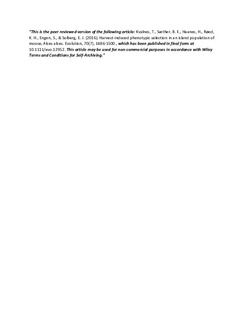| dc.contributor.author | Kvalnes, Thomas | |
| dc.contributor.author | Sæther, Bernt-Erik | |
| dc.contributor.author | Haanes, Hallvard | |
| dc.contributor.author | Røed, Knut | |
| dc.contributor.author | Engen, Steinar | |
| dc.contributor.author | Solberg, Erling Johan | |
| dc.date.accessioned | 2018-03-19T10:17:31Z | |
| dc.date.available | 2018-03-19T10:17:31Z | |
| dc.date.created | 2016-06-09T13:49:12Z | |
| dc.date.issued | 2016 | |
| dc.identifier.citation | Evolution. 2016, 70 (7), 1486-1500. | nb_NO |
| dc.identifier.issn | 0014-3820 | |
| dc.identifier.uri | http://hdl.handle.net/11250/2490982 | |
| dc.description.abstract | Empirical evidence strongly indicates that human exploitation has frequently led to rapid evolutionary changes in wild populations, yet the mechanisms involved are often poorly understood. Here, we applied a recently developed demographic framework for analyzing selection to data from a 20-year study of a wild population of moose, Alces alces. In this population, a genetic pedigree has been established all the way back to founders. We demonstrate harvest-induced directional selection for delayed birth dates in males and reduced body mass as calf in females. During the study period, birth date was delayed by 0.81 days per year for both sexes, whereas no significant changes occurred in calf body mass. Quantitative genetic analyses indicated that both traits harbored significant additive genetic variance. These results show that selective harvesting can induce strong selection that oppose natural selection. This may cause evolution of less favorable phenotypes that become maladaptive once harvesting ceases. Age structure, animal model, microevolution, reproductive value, ungulate | |
| dc.language.iso | eng | nb_NO |
| dc.rights | Attribution-NonCommercial-NoDerivatives 4.0 Internasjonal | * |
| dc.rights.uri | http://creativecommons.org/licenses/by-nc-nd/4.0/deed.no | * |
| dc.title | Harvest-induced phenotypic selection in an island population of moose, Alces alces | nb_NO |
| dc.title.alternative | Harvest-induced phenotypic selection in an island population of moose, Alces alces | nb_NO |
| dc.type | Journal article | nb_NO |
| dc.type | Peer reviewed | nb_NO |
| dc.description.version | publishedVersion | |
| dc.description.version | acceptedVersion | |
| dc.source.pagenumber | 1486-1500 | nb_NO |
| dc.source.volume | 70 | nb_NO |
| dc.source.journal | Evolution | nb_NO |
| dc.source.issue | 7 | nb_NO |
| dc.identifier.doi | 10.1111/evo.12952 | |
| dc.identifier.cristin | 1360543 | |
| dc.relation.project | Norges forskningsråd: 10357100 | nb_NO |
| dc.relation.project | Norges forskningsråd: 223257 | nb_NO |
| dc.relation.project | Andre: Norwegian Environment Agency. | nb_NO |
| dc.relation.project | EU/ERC-2010-AdG 268562 | nb_NO |
| cristin.unitcode | 192,16,1,0 | |
| cristin.unitname | Institutt for basalfag og akvamedisin | |
| cristin.ispublished | true | |
| cristin.fulltext | original | |
| cristin.fulltext | postprint | |
| cristin.qualitycode | 2 | |

